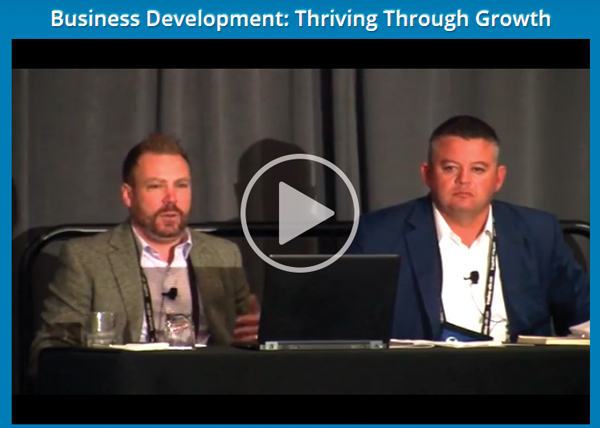BY ROB SMENTEK
 Most CEOs drive company sales, but every member of the team is a potential sales touchpoint for clients—sometimes even more so than the company’s leadership. What smart CEOs know is that effective training and imbuing their team with a sales mentality can help even those in non-selling positions to become a critical part of the company’s overall money-making efforts.
Most CEOs drive company sales, but every member of the team is a potential sales touchpoint for clients—sometimes even more so than the company’s leadership. What smart CEOs know is that effective training and imbuing their team with a sales mentality can help even those in non-selling positions to become a critical part of the company’s overall money-making efforts.
Since business development and growth are hardly industry-specific endeavors, Chauffeur Driven invited two sales experts to share their wisdom during a session at the 2016 CD Show in Washington, D.C. Representing the chauffeured ground transportation industry was Dave Reinhart, CEO of TBR Global in Boston, who has recently seen a substantial growth in his business. Also speaking at the seminar was Wayne Knaub, senior vice president of marketing of RSM Maintenance. While RSM is pretty far removed from transportation—it handles facility maintenance services and management for businesses and restaurants across the country—Knaub’s professional know-how facilitated a staggering 482 percent increase within his market space. Growth is universal business concept, but this session was tailored with smaller operators in mind who just needed that spark to ignite their efforts.
According to Reinhart and Knaub, the single most important objective that owners and CEOs need to pursue is adding value to their organizations. During the session, they offered a series of tips to help operators find ways to add both monetary and cultural value to their companies to continue upward momentum, while nurturing an environment where the entire team is working toward the same goal.
Find What Makes Your Business Tick
Before you can turn your staff into effective salespeople, you need to have a clear vision of what you want to accomplish with your company—and we’re not just talking about profits. Whether you’re catering to corporate America, events and group work, or even proms and weddings, not one vertical market is “better” than another—nor profitable for every company. Knaub advised that operators take a close look to see exactly where revenue is coming from, and build around that core revenue source. This may require the hard decision of ending a certain type of service that is costing more than the job is worth or shedding some fleet, especially if it isn’t giving you the return on investment any longer. What makes you different, better, or stand out from the competition? If you don’t know, you have some work to do.
“Become an expert in your business model,” he said, “and realize you can’t be everything to everyone.” Start small: Choose two or three service areas that you can master, and stick with those to cement your place within that market. But, most importantly, learn that it’s OK to walk away from business. If someone comes to you for a large group move and you and your staff don’t have experience with this type of work, it may be best to step back and let an affiliate or someone else handle the job. While it’s always important to take some risks, you don’t want to put your reputation on the line for what you perceive as easy, quick cash.
“Become an expert in your business model and realize you can’t be everything to everyone.”
– Wayne Knaub of RSM Maintenance
What Is Your Company’s Mission?
After determining where you want to go next as a company, it’s time to put into words why you’re doing it, and that begins with a mission statement. Even a company in business for years will benefit from this exercise because it will steer the course of the future or solidify what you are already doing. The goals in the statement should be clear, concise, and, most of all, obtainable. Employees—in every department—should show up each day understanding what’s expected of them and what the business is reaching for. If they don’t understand where they’re going, how can they help you get there?
When creating the mission statement, Reinhart suggests getting your staff’s proverbial two cents. Engaging your team to get their buy-in is effectively two-fold: It shows them that they are valued, and gives you instant insight into how things are going in the trenches. Furthermore, your mission statement enhances your value as it demonstrates that the company image you’re selling is a true reflection of what you’re doing in the office.
Having team unity also influences your company culture, and Reinhart attributes a great deal of TBR Global’s success to the culture that they’ve established. “Company morale is huge,” he said. “You can’t put a dollar value on it. We look at each employee as a pseudo-salesperson. They’re the individuals who engage with clients each day.”
“Company morale is huge. You can’t put a dollar value on it. We look at each employee as a pseudo-salesperson. They’re the individuals who engage with clients each day.”
– Dave Reinhart of TBR Global
Measure Your Employees on a Consistent Basis
Installing a key performance indicator (KPI) system throughout your company to measure success based on specific business goals and targets will see increased service levels across the board, advised Knaub.
Reinhart and Knaub used reservations as a perfect example of KPI’s effectiveness. Using phone stats and email, it’s easy to measure accuracy, speed, and up-sales. This data will allow you to create reachable goals for the team to meet. At the end of each quarter, you’ll be able to use these metrics in real time to determine who your strongest employees are when it comes time for promotion or raises versus those on your team who may need more guidance or a push. KPIs eliminate any guesswork on the part of the manager and the employee when it comes to knowing where one stands.
“In our company, there isn’t one person who doesn’t have a KPI, each quarter,” added Reinhart. “It’s a must for a manager but also each hourly employee. All of our line managers have one-to-one meetings each month with hourly employees so they know where they stand. They can be easy to install. It allows us to correct mistakes as they happen so they don’t occur again.”
While setting KPIs is relatively simple, it may take a quarter or two to determine whether your metrics are on point and, most importantly, obtainable. It’s a morale killer to have your staff work hard toward a goal they simply cannot meet, and worse, not to give them the tools to meet them. Quarterly bonuses, dress-down Fridays, events, and parties are all ways you can reward your team for meeting KPIs and thank them for a job well done.
“The KPI raised service levels to the highest I’ve ever seen,” said Reinhart. “But they HAVE to be measurable. There are many reservations systems that can provide managers with usable info and make things 100 percent transparent.”
Adopt a Customer Relationship Management System
With KPIs helping to expand your company’s internal communication and results, adding a customer relationship management (CRM) system will improve external relations with potential and existing clients alike. This software allows you to measure revenue targets, pipeline thresholds, profitability, number of calls and meetings, and even social media reviews. You can also create notes like your clients’ birthdays and local events so you can send personal emails—everyone appreciates the personal touch. These days, this type of information is abundant and often highly accessible.
“I encourage you to be a ‘stalker,’” Knaub joked. “I recently had a meeting with three people. I came into the meeting prepared, having researched their backgrounds (school, previous industry) on LinkedIn. I made notes in the CRM profile. It showed that I really cared about the meeting. Any commonality—alma mater, personal interest—that you can share with a client is great.”
 Knaub credits having a CRM as a key to his success. “While your salespeople will always tell you they’re out there working hard and doing their best, using the software I can pull up client reviews to see if sales is making the calls, etc. It’s also helpful when I see a customer because I can document it. It’s also good for recruiting.”
Knaub credits having a CRM as a key to his success. “While your salespeople will always tell you they’re out there working hard and doing their best, using the software I can pull up client reviews to see if sales is making the calls, etc. It’s also helpful when I see a customer because I can document it. It’s also good for recruiting.”
Reinhart also sees benefit in adopting this software. “I’m on the road three to four times a week. Customers ask for more data: They’re smarter now. If you can provide data to a client, it can nip a problem in the bud. It’s important that any system you use can extract stats that you can share.”
When it comes to making changes to your business, whether it’s creating a mission statement, building KPIs, or adopting CRM software, Knaub and Reinhart encourage all operators to be patient. Developing goals, laying out a plan to achieve them, and measuring results takes time, and the number of features offered by CRM software requires you to work hard to understand the functions. Over time, however, these tools will allow you be consistent with your processes, causing you to grow bigger and better. [CD1017]

